PEP小学英语五年级上册Unit 3教学设计
- 格式:docx
- 大小:20.52 KB
- 文档页数:4
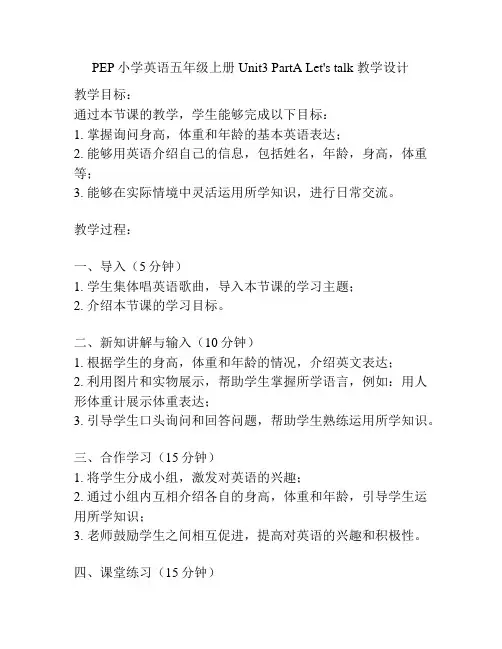
PEP小学英语五年级上册Unit3 PartA Let's talk 教学设计教学目标:通过本节课的教学,学生能够完成以下目标:1. 掌握询问身高,体重和年龄的基本英语表达;2. 能够用英语介绍自己的信息,包括姓名,年龄,身高,体重等;3. 能够在实际情境中灵活运用所学知识,进行日常交流。
教学过程:一、导入(5分钟)1. 学生集体唱英语歌曲,导入本节课的学习主题;2. 介绍本节课的学习目标。
二、新知讲解与输入(10分钟)1. 根据学生的身高,体重和年龄的情况,介绍英文表达;2. 利用图片和实物展示,帮助学生掌握所学语言,例如:用人形体重计展示体重表达;3. 引导学生口头询问和回答问题,帮助学生熟练运用所学知识。
三、合作学习(15分钟)1. 将学生分成小组,激发对英语的兴趣;2. 通过小组内互相介绍各自的身高,体重和年龄,引导学生运用所学知识;3. 老师鼓励学生之间相互促进,提高对英语的兴趣和积极性。
四、课堂练习(15分钟)1. 针对学生所学的内容,老师出一些加减法的口算题,让学生进行计算;2. 将算好的数字转化成英文表达,检验学生的运用能力;3. 激励学生参与,成为课堂积极分子。
五、知识再现与反馈(10分钟)1. 回归教学目标,测试学生对所学知识的掌握情况;2. 将掌握不足的知识进行再次复习和梳理,引导学生形成完整的知识体系;3. 通过短文阅读的方式,让学生实际运用所学知识,强化学生的语言表达能力。
六、课堂扩展(5分钟)1. 鼓励学生在家庭中运用所学知识,与家长进行交流;2. 介绍下一节课的学习内容,激发学生对英语学习的兴趣。
教学方法:1. 导入:通过音乐导入,激发学生学习兴趣;2. 新知讲解与输入:利用多种教学手段,如图片、实物等,帮助学生掌握知识;3. 合作学习:分组合作,增进学生之间的交流;4. 课堂练习:通过口算题和英语表达的练习,检验学生的掌握情况;5. 知识再现与反馈:回归教学目标,强化学生所学知识;6. 课堂扩展:鼓励学生在家中进行英语交流。
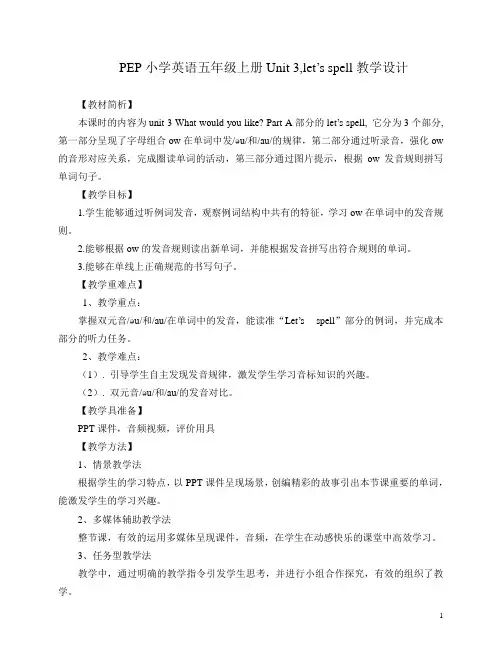
PEP小学英语五年级上册Unit 3,let’s spell教学设计【教材简析】本课时的内容为unit 3 What would you like? Part A部分的let’s spell, 它分为3个部分, 第一部分呈现了字母组合ow在单词中发/əu/和/au/的规律,第二部分通过听录音,强化ow 的音形对应关系,完成圈读单词的活动,第三部分通过图片提示,根据ow发音规则拼写单词句子。
【教学目标】1.学生能够通过听例词发音,观察例词结构中共有的特征,学习ow在单词中的发音规则。
2.能够根据ow的发音规则读出新单词,并能根据发音拼写出符合规则的单词。
3.能够在单线上正确规范的书写句子。
【教学重难点】1、教学重点:掌握双元音/əu/和/au/在单词中的发音,能读准“Let’s spell”部分的例词,并完成本部分的听力任务。
2、教学难点:(1). 引导学生自主发现发音规律,激发学生学习音标知识的兴趣。
(2). 双元音/əu/和/au/的发音对比。
【教学具准备】PPT课件,音频视频,评价用具【教学方法】1、情景教学法根据学生的学习特点,以PPT课件呈现场景,创编精彩的故事引出本节课重要的单词,能激发学生的学习兴趣。
2、多媒体辅助教学法整节课,有效的运用多媒体呈现课件,音频,在学生在动感快乐的课堂中高效学习。
3、任务型教学法教学中,通过明确的教学指令引发学生思考,并进行小组合作探究,有效的组织了教学。
4、游戏教学法通过“Brain Storm”的游戏,让学生在轻松愉悦的环境下巩固新知,提升学生的学习积极性。
【学生学法】针对学生的特点,我采用小组合作和小组间竞赛的学习方式,鼓励他们积极参与课堂开展的各项活动,让学生在教师的指导下,通过猜一猜,说一说,比一比,玩一玩等活动,让学生在动静交错、个人与小组、练习与竞争中学习语言,训练语言,应用语言,形成积极的学习态度。
【教学过程】Step1. Greetings and Warm-up问候及热身以一首节奏欢快的语音歌“A is for apple”引入,让学生试着跟唱,以此提升学生的学习兴趣,不仅了活跃课堂氛围,而且巩固了学生对26的字母发音的认知。
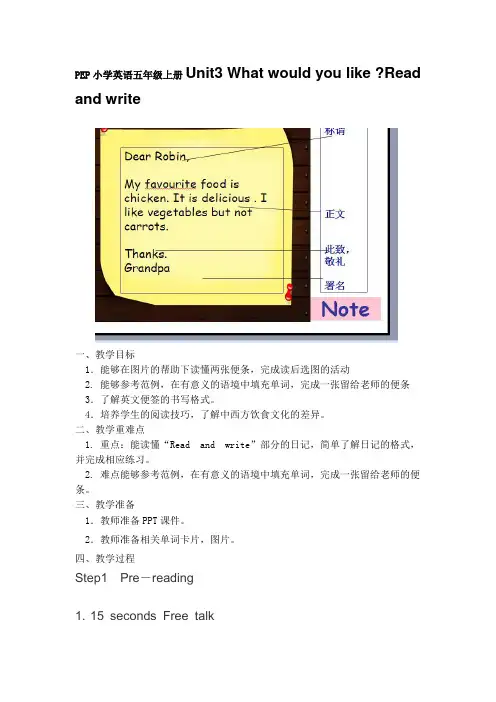
PEP小学英语五年级上册Unit3What would you like ?Read and write一、教学目标1.能够在图片的帮助下读懂两张便条,完成读后选图的活动2. 能够参考范例,在有意义的语境中填充单词,完成一张留给老师的便条3.了解英文便签的书写格式。
4.培养学生的阅读技巧,了解中西方饮食文化的差异。
二、教学重难点1. 重点:能读懂“Read and write”部分的日记,简单了解日记的格式,并完成相应练习。
2. 难点能够参考范例,在有意义的语境中填充单词,完成一张留给老师的便条。
三、教学准备1.教师准备PPT课件。
2.教师准备相关单词卡片,图片。
四、教学过程Step1Pre-reading1. 15 seconds Free talkFree TalkVegetables Fruits Drinks Food【设计意图】老师限定15秒,明确food 、drink 、fruit 、 vegetable 分类词汇,通过小组合作,自由完成自己对单词的回顾练习;2. Enjoy a show.【设计意图】全班在视频的帮助下,再次集体回顾相关词汇,并作为对小组合作的检验,活跃课堂气氛,提高学生学习兴趣为学习文本时的语言输出做铺垫。
Step 2 While -reading1. 呈现本课句型My favourite food is … I like … I don ’t like …”并作练习;2.NoteNoteNoteDear Robin,My favourite food ischicken. It is delicious . I like vegetables but not carrots.Thanks.Grandpa称谓正文此致,敬礼署名学生观察便条的格式,教师稍作讲解:英文便条一般由4部分组成,即:称呼、正文、结束语和署名。
正文开头部分一般顶格写上“Dear …”,意为“亲爱的……”,结尾应署上姓名。
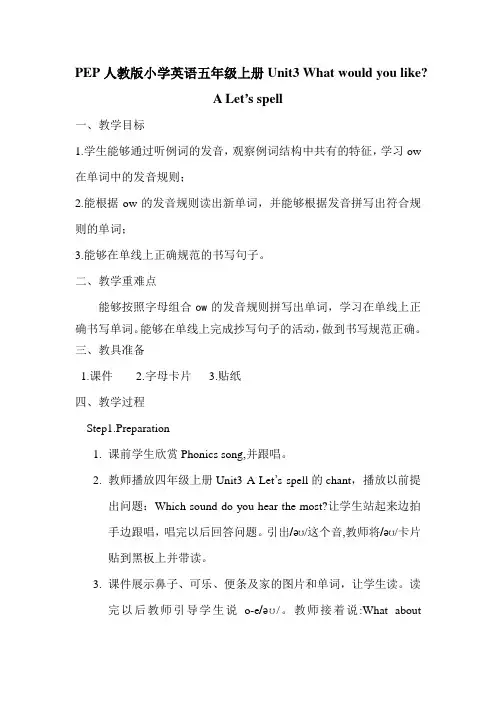
PEP人教版小学英语五年级上册Unit3 What would you like?A Let’s spell一、教学目标1.学生能够通过听例词的发音,观察例词结构中共有的特征,学习ow 在单词中的发音规则;2.能根据ow的发音规则读出新单词,并能够根据发音拼写出符合规则的单词;3.能够在单线上正确规范的书写句子。
二、教学重难点能够按照字母组合ow的发音规则拼写出单词,学习在单线上正确书写单词。
能够在单线上完成抄写句子的活动,做到书写规范正确。
三、教具准备1.课件2.字母卡片3.贴纸四、教学过程Step1.Preparation1.课前学生欣赏Phonics song,并跟唱。
2.教师播放四年级上册Unit3 A Let’s spell的chant,播放以前提出问题:Which sound do you hear the most?让学生站起来边拍手边跟唱,唱完以后回答问题。
引出/əʊ/这个音,教师将/əʊ/卡片贴到黑板上并带读。
3.课件展示鼻子、可乐、便条及家的图片和单词,让学生读。
读完以后教师引导学生说o-e/əʊ/。
教师接着说:What aboutow?Let’s see together.Step2.Presentation1.课件展示窗户的图片,问学生:What’s this?学生回答:It’s a window.课件出示句子:Window, window, look out of my window.让生齐读。
接着打开窗户,展示下雪的图片,教师说:Look, it’s snowy.然后出示句子Snow, snow, it's snowy.学生齐读句子。
教师指着蜗牛的图片说:Look at the snail. It’s slow.接着出示句子:Slow, slow, it’s slow. 学生齐读。
同样展示句子:Yellow, yellow, I see yellow.学生齐读。
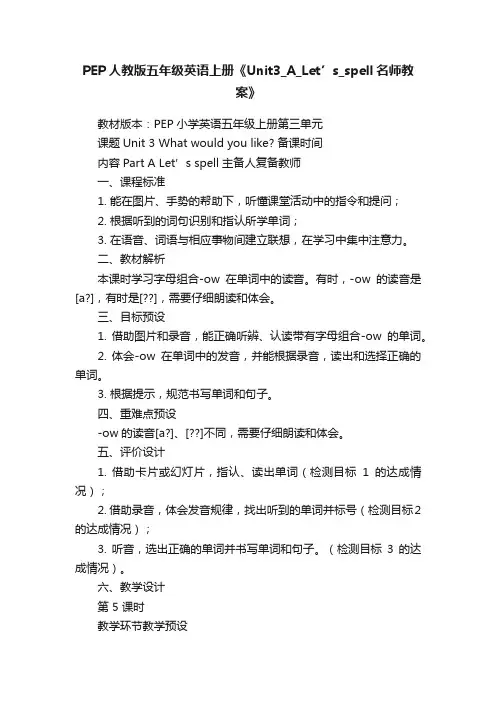
PEP人教版五年级英语上册《Unit3_A_Let’s_spell名师教案》教材版本:PEP小学英语五年级上册第三单元课题Unit 3 What would you like? 备课时间内容Part A Let’s spell主备人复备教师一、课程标准1. 能在图片、手势的帮助下,听懂课堂活动中的指令和提问;2. 根据听到的词句识别和指认所学单词;3. 在语音、词语与相应事物间建立联想,在学习中集中注意力。
二、教材解析本课时学习字母组合-ow在单词中的读音。
有时,-ow的读音是[a?],有时是[??],需要仔细朗读和体会。
三、目标预设1. 借助图片和录音,能正确听辨、认读带有字母组合-ow的单词。
2. 体会-ow在单词中的发音,并能根据录音,读出和选择正确的单词。
3. 根据提示,规范书写单词和句子。
四、重难点预设-ow的读音[a?]、[??]不同,需要仔细朗读和体会。
五、评价设计1. 借助卡片或幻灯片,指认、读出单词(检测目标1的达成情况);2. 借助录音,体会发音规律,找出听到的单词并标号(检测目标2的达成情况);3. 听音,选出正确的单词并书写单词和句子。
(检测目标3的达成情况)。
六、教学设计第 5 课时教学环节教学预设一、热身/复习(Warm-up/Revision)导入:字母操复习:出示上两个单元的字母组合词汇,进行听音和辨音的练习。
“礼物大比拼”:进行小组PK活动,贯穿课堂,语音课有些枯燥,用竞赛的形式进行,可以提高学生参与的积热身活动:选择一个礼品盒,开启PK模式。
全班分为两大组。
拼读单词Chant朗读二、呈现新课(Presentation)1. 导入新课:小组PK活动,用来激发学生的兴趣。
Can you read these words?cow flower wow downslow snow yellow window(每读出一个单词,奖励一件礼物。
)Can you find the same part of these words? What does it sound?学生体会-ow的发音,尝试分解音素[a?]、[??](说出发音规律,奖励2件礼物。
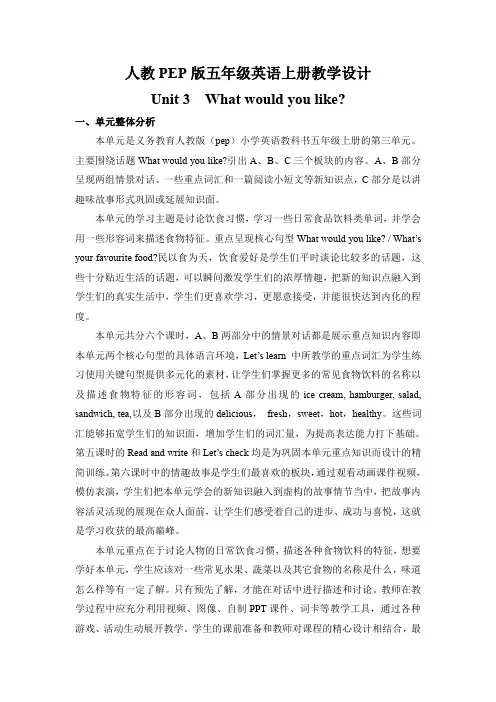
人教PEP版五年级英语上册教学设计Unit3What would you like?一、单元整体分析本单元是义务教育人教版(pep)小学英语教科书五年级上册的第三单元。
主要围绕话题What would you like?引出A、B、C三个板块的内容。
A、B部分呈现两组情景对话、一些重点词汇和一篇阅读小短文等新知识点,C部分是以讲趣味故事形式巩固或延展知识面。
本单元的学习主题是讨论饮食习惯,学习一些日常食品饮料类单词,并学会用一些形容词来描述食物特征。
重点呈现核心句型What would you like?/What’s your favourite food?民以食为天,饮食爱好是学生们平时谈论比较多的话题,这些十分贴近生活的话题,可以瞬间激发学生们的浓厚情趣,把新的知识点融入到学生们的真实生活中,学生们更喜欢学习,更愿意接受,并能很快达到内化的程度。
本单元共分六个课时,A、B两部分中的情景对话都是展示重点知识内容即本单元两个核心句型的具体语言环境,Let’s learn中所教学的重点词汇为学生练习使用关键句型提供多元化的素材,让学生们掌握更多的常见食物饮料的名称以及描述食物特征的形容词,包括A部分出现的ice cream,hamburger,salad, sandwich,tea,以及B部分出现的delicious,fresh,sweet,hot,healthy。
这些词汇能够拓宽学生们的知识面,增加学生们的词汇量,为提高表达能力打下基础。
第五课时的Read and write和Let’s check均是为巩固本单元重点知识而设计的精简训练。
第六课时中的情趣故事是学生们最喜欢的板块,通过观看动画课件视频,模仿表演,学生们把本单元学会的新知识融入到虚构的故事情节当中,把故事内容活灵活现的展现在众人面前,让学生们感受着自己的进步、成功与喜悦,这就是学习收获的最高巅峰。
本单元重点在于讨论人物的日常饮食习惯,描述各种食物饮料的特征,想要学好本单元,学生应该对一些常见水果、蔬菜以及其它食物的名称是什么,味道怎么样等有一定了解。
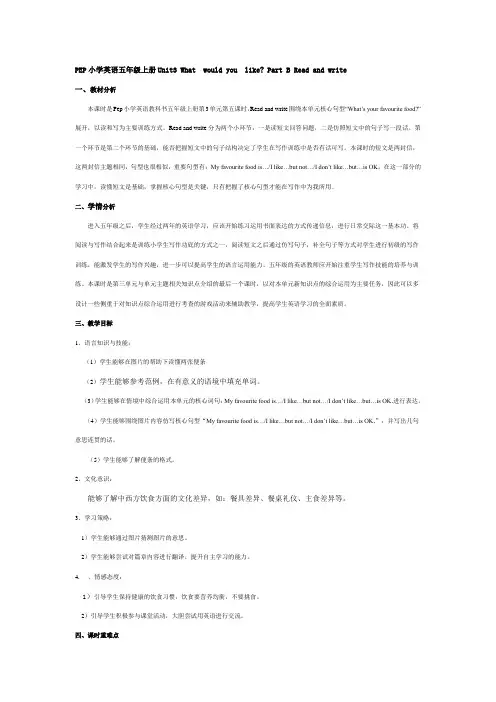
PEP小学英语五年级上册Unit3 What would you like? Part B Read and write一、教材分析本课时是Pep小学英语教科书五年级上册第3单元第五课时,Read and write围绕本单元核心句型“What’s your favourite food?”展开,以读和写为主要训练方式。
Read and write分为两个小环节:一是读短文回答问题,二是仿照短文中的句子写一段话。
第一个环节是第二个环节的基础,能否把握短文中的句子结构决定了学生在写作训练中是否有话可写。
本课时的短文是两封信,这两封信主题相同,句型也很相似,重要句型有:My favourite food is…/I like…but not…/I don’t like…but…is OK。
在这一部分的学习中,读懂短文是基础,掌握核心句型是关键,只有把握了核心句型才能在写作中为我所用。
二、学情分析进入五年级之后,学生经过两年的英语学习,应该开始练习运用书面表达的方式传递信息,进行日常交际这一基本功。
将阅读与写作结合起来是训练小学生写作功底的方式之一,阅读短文之后通过仿写句子,补全句子等方式对学生进行初级的写作训练,能激发学生的写作兴趣,进一步可以提高学生的语言运用能力。
五年级的英语教师应开始注重学生写作技能的培养与训练。
本课时是第三单元与单元主题相关知识点介绍的最后一个课时,以对本单元新知识点的综合运用为主要任务,因此可以多设计一些侧重于对知识点综合运用进行考查的游戏活动来辅助教学,提高学生英语学习的全面素质。
三、教学目标1、语言知识与技能:(1)学生能够在图片的帮助下读懂两张便条(2)学生能够参考范例,在有意义的语境中填充单词。
(3)学生能够在情境中综合运用本单元的核心词句:My favourite food is…/I like…but not…/I don’t like…but…is OK.进行表达。
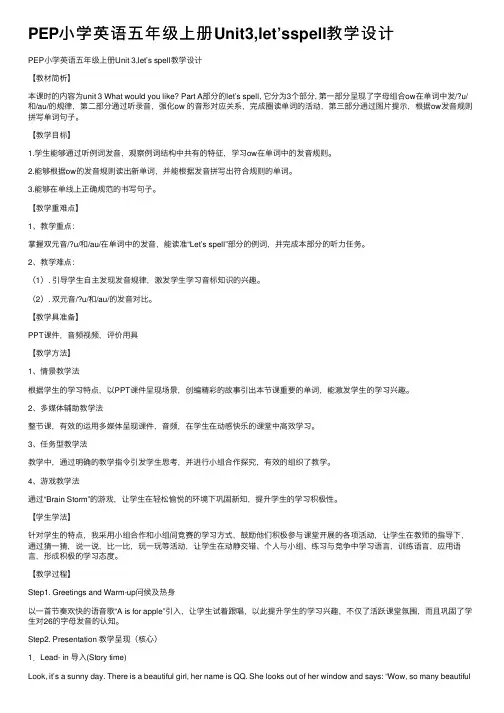
PEP⼩学英语五年级上册Unit3,let’sspell教学设计PEP⼩学英语五年级上册Unit 3,let’s spell教学设计【教材简析】本课时的内容为unit 3 What would you like? Part A部分的let’s spell, 它分为3个部分, 第⼀部分呈现了字母组合ow在单词中发/?u/和/au/的规律,第⼆部分通过听录⾳,强化ow 的⾳形对应关系,完成圈读单词的活动,第三部分通过图⽚提⽰,根据ow发⾳规则拼写单词句⼦。
【教学⽬标】1.学⽣能够通过听例词发⾳,观察例词结构中共有的特征,学习ow在单词中的发⾳规则。
2.能够根据ow的发⾳规则读出新单词,并能根据发⾳拼写出符合规则的单词。
3.能够在单线上正确规范的书写句⼦。
【教学重难点】1、教学重点:掌握双元⾳/?u/和/au/在单词中的发⾳,能读准“Let’s spell”部分的例词,并完成本部分的听⼒任务。
2、教学难点:(1). 引导学⽣⾃主发现发⾳规律,激发学⽣学习⾳标知识的兴趣。
(2). 双元⾳/?u/和/au/的发⾳对⽐。
【教学具准备】PPT课件,⾳频视频,评价⽤具【教学⽅法】1、情景教学法根据学⽣的学习特点,以PPT课件呈现场景,创编精彩的故事引出本节课重要的单词,能激发学⽣的学习兴趣。
2、多媒体辅助教学法整节课,有效的运⽤多媒体呈现课件,⾳频,在学⽣在动感快乐的课堂中⾼效学习。
3、任务型教学法教学中,通过明确的教学指令引发学⽣思考,并进⾏⼩组合作探究,有效的组织了教学。
4、游戏教学法通过“Brain Storm”的游戏,让学⽣在轻松愉悦的环境下巩固新知,提升学⽣的学习积极性。
【学⽣学法】针对学⽣的特点,我采⽤⼩组合作和⼩组间竞赛的学习⽅式,⿎励他们积极参与课堂开展的各项活动,让学⽣在教师的指导下,通过猜⼀猜,说⼀说,⽐⼀⽐,玩⼀玩等活动,让学⽣在动静交错、个⼈与⼩组、练习与竞争中学习语⾔,训练语⾔,应⽤语⾔,形成积极的学习态度。
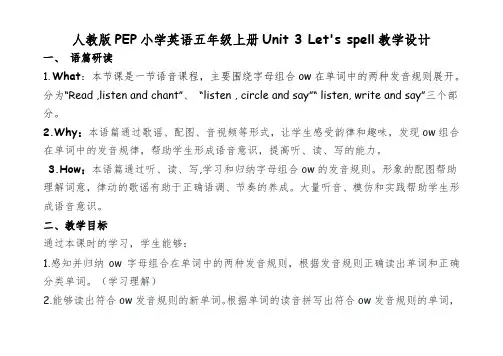
人教版PEP小学英语五年级上册Unit 3 Let's spell教学设计
一、语篇研读
1.What:本节课是一节语音课程,主要围绕字母组合ow在单词中的两种发音规则展开。
分为“Read ,listen and chant”、“listen , circle and say”“ listen, write and say”三个部分。
2.Why:本语篇通过歌谣、配图、音视频等形式,让学生感受韵律和趣味,发现ow组合在单词中的发音规律,帮助学生形成语音意识,提高听、读、写的能力。
3.How:本语篇通过听、读、写,学习和归纳字母组合ow的发音规则。
形象的配图帮助理解词意,律动的歌谣有助于正确语调、节奏的养成。
大量听音、模仿和实践帮助学生形成语音意识。
二、教学目标
通过本课时的学习,学生能够:
1.感知并归纳ow字母组合在单词中的两种发音规则,根据发音规则正确读出单词和正确分类单词。
(学习理解)
2.能够读出符合ow发音规则的新单词。
根据单词的读音拼写出符合ow发音规则的单词,
能够在单线上完成抄写句子的活动。
(应用实践)
3.运用语音规则阅读英语故事,通过语音的变化表达意义和观点,反映态度、意图和情感。
(迁移创新)
完成课时目标所需的核心语言如下:
【核心词语】cow,flower,wow,down,slow,snow,yellow,window
【核心句型】It’s “ow”.“ow”here says...
三、教学过程
四、表现性任务及评价量规。
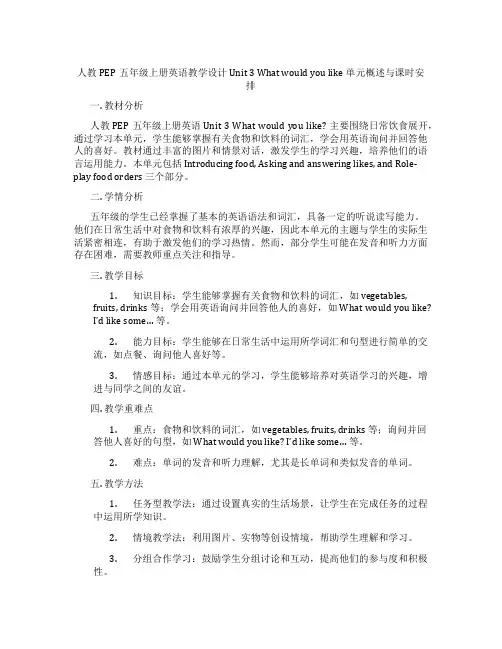
人教PEP五年级上册英语教学设计 Unit 3 What would you like 单元概述与课时安排一. 教材分析人教PEP五年级上册英语Unit 3 What would you like? 主要围绕日常饮食展开,通过学习本单元,学生能够掌握有关食物和饮料的词汇,学会用英语询问并回答他人的喜好。
教材通过丰富的图片和情景对话,激发学生的学习兴趣,培养他们的语言运用能力。
本单元包括 Introducing food, Asking and answering likes, and Role-play food orders 三个部分。
二. 学情分析五年级的学生已经掌握了基本的英语语法和词汇,具备一定的听说读写能力。
他们在日常生活中对食物和饮料有浓厚的兴趣,因此本单元的主题与学生的实际生活紧密相连,有助于激发他们的学习热情。
然而,部分学生可能在发音和听力方面存在困难,需要教师重点关注和指导。
三. 教学目标1.知识目标:学生能够掌握有关食物和饮料的词汇,如 vegetables,fruits, drinks 等;学会用英语询问并回答他人的喜好,如 What would you like?I’d like some… 等。
2.能力目标:学生能够在日常生活中运用所学词汇和句型进行简单的交流,如点餐、询问他人喜好等。
3.情感目标:通过本单元的学习,学生能够培养对英语学习的兴趣,增进与同学之间的友谊。
四. 教学重难点1.重点:食物和饮料的词汇,如 vegetables, fruits, drinks 等;询问并回答他人喜好的句型,如What would you like? I’d like some… 等。
2.难点:单词的发音和听力理解,尤其是长单词和类似发音的单词。
五. 教学方法1.任务型教学法:通过设置真实的生活场景,让学生在完成任务的过程中运用所学知识。
2.情境教学法:利用图片、实物等创设情境,帮助学生理解和学习。
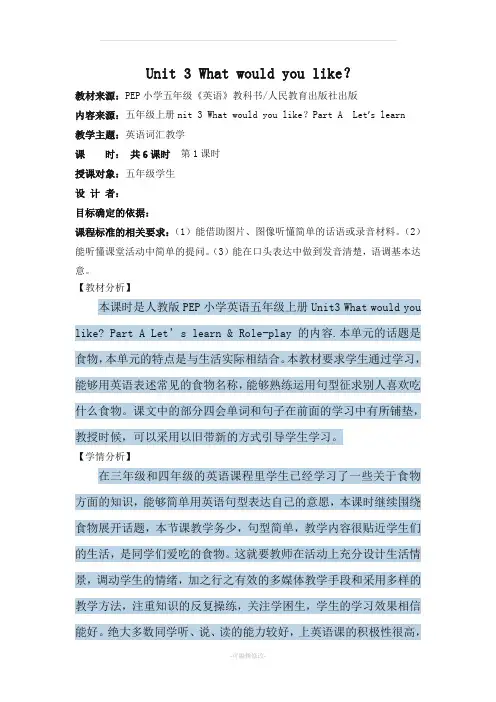
Unit 3 What would you like?教材来源:PEP小学五年级《英语》教科书/人民教育出版社出版内容来源:五年级上册nit 3 What would you like?Part A Let’s learn教学主题:英语词汇教学课时:共6课时第1课时授课对象:五年级学生设计者:目标确定的依据:课程标准的相关要求:(1)能借助图片、图像听懂简单的话语或录音材料。
(2)能听懂课堂活动中简单的提问。
(3)能在口头表达中做到发音清楚,语调基本达意。
【教材分析】本课时是人教版PEP小学英语五年级上册Unit3 What would you like? Part A Let’s learn & Role-play的内容.本单元的话题是食物,本单元的特点是与生活实际相结合。
本教材要求学生通过学习,能够用英语表述常见的食物名称,能够熟练运用句型征求别人喜欢吃什么食物。
课文中的部分四会单词和句子在前面的学习中有所铺垫,教授时候,可以采用以旧带新的方式引导学生学习。
【学情分析】在三年级和四年级的英语课程里学生已经学习了一些关于食物方面的知识,能够简单用英语句型表达自己的意愿,本课时继续围绕食物展开话题,本节课教学务少,句型简单,教学内容很贴近学生们的生活,是同学们爱吃的食物。
这就要教师在活动上充分设计生活情景,调动学生的情绪,加之行之有效的多媒体教学手段和采用多样的教学方法,注重知识的反复操练,关注学困生,学生的学习效果相信能好。
绝大多数同学听、说、读的能力较好,上英语课的积极性很高,只有几个同学程度一般,教师在课堂上给予重点关注,让他们很好地融入到学习中,使他们在有趣的课堂活动中感知语言。
【学习目标】1)能够听,说,读,写本课核心词汇hamburger、sandwich、salad、ice-cream、tea。
做到发音清晰准确。
2)学生能够利用核心句型What would you like to eat/drink? I’d like…运用上述词汇。
PEP小学英语五年级上册Unit3 PartA Let's spell 教学设计教学目标:1. 通过本课的教学,学生能够正确拼写26个字母。
2. 能够运用26个字母进行单词拼写。
3. 能够对字母的发音有基本的认识和了解。
教学重点:26个英文字母的拼写和发音。
教学难点:单词拼写以及不同音节下字母的发音。
教学内容:1. 26个英文字母的拼写和发音。
2. 单词拼写。
教学步骤:Step 1 Warm-up1. Greetings: Say hello to students and get students to say their names.2. Sing a song: “The Alphabet Song”3. Show the letters on the board and ask students to recognize which letters they are. After students have recognized the letters, teacher asks a student to come to the board to write a letter.4. Instruct students to listen to the sounds of the letters and practice pronunciation of letters.5. Ask students to recite the letters with the teacher.6. Play a game to check their memory of the letters. Teacher shows the letters one by one and students call out the name of the letter.Step 2 Presentation1. Show the Powerpoint of the 26 letters along with their pronunciation.2. Teach students some words that contain the letters presented, such as car, egg, dog, pen, and so on.Step 3 Practice1. Show flashcards with simple words (such as cat, dog, pen, etc.) and ask students to spell the words with the letters presented.2. Instruct students to spell some of the words they know.Step 4 GamePlay a game of spelling bee: Divide the students into two groups. The teacher says a word and the first student from each group writes the word on the board. The group that spells the word correctly first gets a point. Continue until all students have participated.Step 5 Closure1. Review the letters presented and their pronunciation.2. Give students positive feedback on their progress in learning the letters.教学资源:1. PPT2. Flashcards3. Spelling bee game教学评估:1. Observe students' behavior during the lesson to ensure they areengaged and motivated.2. Conduct a spelling test at the end of the lesson to assess their understanding of the letters presented.3. Give feedback to students during the spelling bee game to assess their ability to apply the knowledge they acquired.。
Pep教材五年级上册Unit3.Whatwouldyoulike教学设计Pep教材五年级上册Unit 3. What would you like? 教学设计第⼀课时(Part A. Let’s learn )⼀、教材分析本节课以饮⾷为主线,重点学习⾷品饮料类、⾷物类单词、词组和句型,并能在适当的情景中谈论⾃⼰喜欢的⾷物和饮品。
整节课围绕⾃⼰喜欢的⾷物展开⼀系列话题,帮助学⽣表达⾃⼰喜欢的⾷物、饮料,并懂得保持健康的饮⾷习惯。
教学时让学⽣通过完成各种任务活动来感知和巩固新的知识点,减轻教学难度,增加学习兴趣。
⼆、学情分析学⽣对于⾃⼰喜欢的⾷物是⾮常感兴趣的,三四年级已经学过部分⽔果类和⾷物类单词,因此学⽣对进⼀步学习是很有兴趣的,因此,必须运⽤各种教学⼿段激起学⽣的兴趣,调动学⽣的积极性,这也是⼩学英语教学的⽬标之⼀。
由于本单元内容与学⽣的⽇常⽣活联系密切,教学时,要根据⼩学⾼年级阶段学⽣的特点,引导他们在学习英语的过程中最⼤限度地发挥⾃主学习能⼒,积极主动地学习英语。
三、教学⽬标1、知识⽬标:能听、说、读、写单词hamburger,sandwich, ice cream,, tea, salad和句型What would you like to eat?I’d like…2、能⼒⽬标:学⽣利⽤本课所学内容去询问别⼈喜欢的⾷物并表述⾃⼰喜欢的⾷物。
3、情感⽬标:了解西⽅饮⾷特点和⽂化,培养学⽣健康的饮⾷习惯。
四、教学重难点教学重点1. 学习有关饮⾷的⽣词ice cream, hamburger, tea, sandwich和salad等.2. 针对饮⾷爱好进⾏询问和回答,谈论⾃⼰喜欢的⾷物。
教学难点1. 单词hamburger,sandwich的读⾳和拼写。
2. 句型What would you like to eat?I’d like…的熟练运⽤。
五、教学过程―)课前热⾝(Warm-up)1、Hello, boys and girls. Welcome to my English class! My name is lily,nice to meet you! Ss: nice to meet you too!2、This is lily. PPT(出⽰我的图⽚及爱好)can you say something aboutme?(学⽣说lily likes reading, lily likes playing sports…)Yes, I like reading books. I like playing sports. I like traveling. I likesinging. Do you like singing? Let’s sing a song! Listen: Apple round,apple red, apple juice apple sweet. Apple apple I love you, apple sweet Ilove to e at! Ok, thank you! This time let’s sing it together. Ok? Showme your hands!3、And I also like cooking. I cooked a lot of good foods and shared it on myblog. Look, the good foods. And this is my blog.4、This is my new restaurant. I need somebody to help me. Would you liketo help me? Ok. Thank you! Let’s have some training! We hav e fivetasks. Are you ready? Ready, go!(设计意图:通过师⽣交流,在轻松愉快的氛围中,开始新课程的学习,创设餐厅招聘服务员的情境,学⽣参与其中,通过完成⼀个个培训任务,⽽完成教学⽬标,增加课程的趣味性。
人教 PEP 版五年级英语上册第三单元教案Unit3 What would you like ? 教学设计A Let’s try & let’s talk一、教学设计整体思路新版小学英语教材五年级的对话课,建议教学应设计有效的听说活动,让学生在有意义的语境中进行与话题相关的听、说练习并综合运用语言。
本课教学内容的主题是What would you like?,本课时要求学生能够在情景中运用句型What would you like to eat / drink ? I’d like…询问并回答自己想吃什么、喝什么。
教师先是通过情景创设引入对话,再通过层层操练加以强化,最后以任务型的活动促使学生综合运用对话,即从原定场景对话的文本建构到选定场景的创造性文本重构逐步体现语言学习的感知、体验、内化和运用过程。
二、教学目标语言知识技能目标:1、学生能够在图片和教师的帮助下理解对话内容;2、能够按照正确的意群及语音、语调朗读对话,并能进行角色表演;3、能够在情景中运用句型What would you like to eat / drink ? I’d like…询问并回答自己想吃什么、喝什么。
4、能在任务中再构核心语言并灵活运用语言。
学习策略目标:通过游戏教学、同桌合作、故事预测等方式激活思维,尝试阅读对话内容。
情感态度目标:通过本课的对话学习,引导学生安排合理健康的饮食。
三、教学重难点重点:1、能表演所学对话;2、能够在情景中运用句型What would you like to eat / drink ? I’d like…询问并回答自己想吃什么、喝什么.难点:用英语准确询问他人所需要的饮料和食物。
四、教学过程:Step1warm-upA song <apple juice>设计意图:活跃课堂气氛,并复习相关饮食和饮料单词,以及相关的动词,为下面的学习做好铺垫。
Step 2 Pre-reading1.Lead in with Sharp eyesSharp eyes 游戏:PPT 迅速出现食物和饮料的单词,学生快速说出,复习原来所学单词。
PEP小学英语五年级上册Unit 3 A Let’s talk教学设计一、整体设计思路、指导依据说明根据学习内容,通过情景化教学,将课堂整个置于“餐厅中”的故事主线当中。
从开课教师开办自己的餐厅,邀请学生就餐;介绍如何点餐,引出新句型;学生自由合作,在餐厅中点餐;最后通过对话表演展示。
根据情景的设定,采用任务型教学驱动。
通过不同形式的任务进行每一个教学点的处理。
学生在教师精心设计的活动中,充分感受、体验、了解、学习、练习语言知识和语言文化差异。
根据建构式教学原理,依据五年级学生年龄、认知、知识经验、学习能力等特点,通过层层递进的学习环节,以旧引新,教师呈现单词认读方法(自然拼读法如thirsty)的学法指导,引导学生开展探究式拼读单词,培养学生单词认读学习能力。
通过在情境中应用、引入、巩固、操练句型。
通过小组活动,培养学生合作意识、参与意识。
二、教学背景1、教学内容分析:义务教育教科书英语(三年级起点)五年级上册 Unit 3 What would you like? Part A Let’s talk.新学内容:单词:sandwich, thirsty 句型: What would you l ike to eat/drink? I’d like a/an/some …, please. Here you are. Thank you. You’re welcome.等。
2. 学生情况分析:首先,学生通过两年来的英语学习,具备了一定的语感、语音知识和单词拼读的能力,可以自己尝试拼读单词。
同时也积累了一定的语言表达能力,能适当的进行对话活动。
三、教学目标1. 语言知识目标:(1)能够听懂单词sandwich, thirsty理解其意思,并能正确朗读。
(2)能够使用句子What would yo u like to eat/drink? I’d like a/an/some …, please. 进行口语问答。
人教版PEP五年级上册英语《Unit 3 What would you like第一课时》教学设计一. 教材分析《Unit 3 What would you like》是人教版PEP五年级上册英语的教学内容,本单元主要围绕食物和饮料的主题,让学生学会用英语询问并回答别人想要什么食物和饮料。
本课时的教学内容主要包括食物和饮料的词汇,以及询问别人想要什么的句型。
二. 学情分析五年级的学生已经掌握了基本的英语语法和词汇,具备了一定的听、说、读、写的能力。
但是对于一些食物和饮料的词汇可能还没有接触过,因此在教学过程中需要教授新词汇。
同时,学生对于询问别人想要什么的句型也可能是第一次接触,需要通过反复操练来掌握。
三. 教学目标1.能听懂、会说、会读本课时的核心词汇:pizza, hot dog, ice cream,milk, water。
2.能用英语询问并回答别人想要什么食物和饮料。
3.能用英语简单描述自己的喜好。
四. 教学重难点1.重点:食物和饮料的词汇,以及询问别人想要什么的句型。
2.难点:食物和饮料的词汇的准确发音和记忆,以及询问别人想要什么的句型的运用。
五. 教学方法采用情境教学法、游戏教学法和任务型教学法,通过设定情境、游戏和任务,让学生在实际语境中学习和运用语言。
六. 教学准备1.准备食物和饮料的图片或实物。
2.准备教学课件和教案。
3.准备录音机或播放器,准备本课时的录音材料。
七. 教学过程1.导入(5分钟)通过播放本课时的录音,让学生初步感知本课时的主题和内容。
然后老师通过提问学生“What would you like?”来引导学生回答自己喜欢的食物和饮料。
2.呈现(10分钟)老师通过展示食物和饮料的图片或实物,教授本课时的核心词汇:pizza, hot dog, ice cream, milk, water。
同时,老师用“What would you like?”的句型来询问学生,让学生用英语回答。
五年级上Unit 3What would you like? B Let’s talkITeaching contents(教材分析):本课时是PEP Primary English五年级上册第三单元B Let’s talk的内容,课文以学生小组合作的形式表现了三个交际句型。
与生活贴近,具有较强的交际性。
II Students analysis(学情分析):本课时的教学对象是五年级的学生,他们已经有一定的口语交际基础,有一定的听、说、读、写水平,能就自己喜爱的话题提出相对应的问题,能够积极的实行自主学习、合作学习完成学习任务。
III Teaching aims and requirements(教学目标):1.Knowledge and abilities(知识技能目标):1)学习相关日常饮食询问的表达法:What’s your favourite food/drink? My favourite food/drink is … Well, let’s see. 并能把这些句子用在实际生活情景中熟练地使用。
2)掌握常见的食物和饮料表达法:beef noodles, fish sandwich, tomato soup, milk。
2.Emotion and tactics(情感态度目标):1) 倡导健康饮食,多吃蔬菜和水果。
2) 热爱生活,学会就这些最喜欢的事情做简单交流。
3. Learning strategy target(学习策略目标):同学之间积极合作,共同完成学习任务。
IV Key points and difficult points(教学重难点):1.Key points:学习相关日常饮食询问的表达法:What’s your favourite food/drink? My favourite food/drink is …Well, let’s see. 并能把这些句子用在实际生活情景中熟练地使用。
PEP小学英语五年级上册Unit 3(第二课时)教学设计望谟一小教师:王艳2010.5.19教学内容:PEP小学英语五年级上册Unit 3 的第二课时,包括:A .Let's try Let's talk Talk and matchC .Good to know教学目标:(一)、知识目标:能听懂、会说句子“What do you have for breakfast/lunch/dinner today?和句子I have …并能在实际情景中进行运用。
(二)、能力目标:1、能听懂提示语,按照Let's try 的录音内容判断两张配图的正误。
2、能够用英语“点菜”。
3、能够相互调查一日三餐的用餐情况4、能用英语设计出适合小学生一日三餐的营养食谱。
(三)、情感、策略、文化目标:1、用任务型语言教学途径,让学生在“做”中学,激发学生学习英语的兴趣。
培养学生学习英语的积极态度,使学生乐于合作参与,勇于进行交际实践。
2、了解中西方饮食方面的不同之处。
语言任务:在本次教学活动过程中,教师是组织者,起引导作用;学生是“主角”,是活动的主体,他们以小组为单位,进行口语、笔头练习。
教师和学生之间既是师生关系,同时也互相合作、交流,因此又是合作伙伴关系。
这次活动采用情景法、交际法及“任务型”教学途径。
在教学过程中,关注学生的情感,尊重每个学生,保护他们的自尊心和积极性,营造宽松、民主的教学氛围,建立融洽、和谐的师生交流渠道,依据本单元的教学目标,并结合教学内容设计贴近学生实际的教学活动,鼓励他们在学习中尝试,吸引和组织他们积极参与,从而培养学生的合作精神和语言运用能力。
教学重、难点:教学重点是能熟练使用句子“What do you have for breakfast/lunch/dinner today? 和句子I have …进行问答练习。
教学难点是句子“What would you like for lunch?”与“What do you have for lunch today?”的不同用法,以及对话的理解与拓展。
课前准备:1、教师准备Good to know部分的挂图或手绘图。
2、教师准备录音机和有关录音带。
3、多媒体课件。
4、英文菜单若20份。
5、一日三餐调查表格(按学生人数)教学过程:Warm-up1 、Let's chant:What Do You Have For Lunch?教师放本单元第一页上歌谣的录音,让学生跟着旋律一起唱。
(设计意图:让学生唱一唱,达到活跃课堂气氛的效果。
而且本首歌曲的内容又和本节课的教学内容相联系,使学生的思绪很快从课外回到课堂中来。
)2、Free talk:(会话参考)T:I like …, What would you like?S1:I'd like some …教师与学生问答完后,学生之间再互相问答,(对没有学过的食物单词允许学生说中文,教师说出英文。
)(设计意图:Free talk通过课前的对话,热身活动,既活跃了课堂气氛,调动了学生的学习兴趣,培养了学生的口语会话能力,又为下面交流的一日三餐埋下伏笔。
)Preview做“猜谜语”游戏。
教师描述食物特征,让学生猜出食物名称。
(设计意图:通过该游戏既能复习学过的单词又可以激发学生的学习兴趣,培养学生的想象能力,并使学生对后面的学习活动产生探求欲望。
)Let's try教师播放Let's try部分的录音,请学生做出正确判断。
教师再放一遍,检查学生判断的正误。
(设计意图:本环节让学生从听觉上感知主要句型,并完成听音判断的练习,既可以提高学生的听力,又可以训练学生的快速反应能力。
并为学习新知识Let's talk 部分打下基础。
)Presentation(一)、Let's talk (呈现完成任务需要的知识,介绍任务的要求和实施任务的步骤)教师出示课件(根据学习情境设计:一个小学生放学后回家来到厨房)T:Look at the screen, can you guess the topic of this class from the picture?Ss:Eating.(教师引导学生说出)T:Do you know what Mike will say to Mom?学生思考后试着回答。
教师再放一遍课件,然后教师引导学生说出。
Mike: Mom, I'm hungry, What's for dinner ? I'd like some soup and rice Mom: OK, Wait and see(设计意图:采用情景教学的方法,借助多媒体音、形、色、图文并茂的优势,为学生提供真实的语言环境,使语言学习在生活场景中更有生命的活力。
并感知本课的话题是“用餐”,开门见山,切入主题。
)情景对话(设计数个微型任务,构成任务链,学生一个人或小组形式完成各项任务)T:(扮演Mom)Mike,What do you have for dinner today?S1: I have …T: What about you ? (Ask another student)S2: I have…教师和学生表演后,再让学生与学生之间进行表演。
让学生两人一组,一个人扮演Mike,另一个人扮演Mom,假设两个人在厨房里分别运用上旧句型::“What would you like for lunch?”与新句型:“What do you have for lunch today?”进行用餐前的对话。
并让学生理解和感知旧句型::“What would you like for lunch?”与新句型:“What do you have for lunch today?”的不同,教师可稍作讲解。
(设计意图:通过此活动,使学生学会运用句型:What do you have for breakfast/lunch/dinner?和句子I have… 为完成后面的任务活动打下基础。
并突破了难点“What would you like for lunch?”与“What do you have for lunch today?”的不同用法。
)T:After class, Mike and Sarah go home.They are very hungry. What do Mike has for dinner today?What do Sarah has for dinner today?1、把学生四人一组,教师发给学生打乱顺序的课文(Let's talk)内容。
2、让学生把课文内容按照一定的顺序排列起来。
3、再指名学生读排列好的课文,并说说为什么这样排列。
4、让学生打开课本,读Let's talk课文。
教师放Let's talk部分的录音,让学生跟读句子,然后再自己读课文。
(设计意图:整体输入课文,让学生带着问题排列课文能使学生感兴趣愿意做。
做排序任务,有助于学生对课文的理解。
)(设计意图:通过表演既可以使学生理解课文内容,又能充分调动学生学习英语兴趣,同时对新知识进行了一定的拓展。
)(二)、Talk and match学生两人一组进行练习,完成Talk and match部分说说连连活动。
(设计意图:进一步巩固新句型:What do you have for lunch today? 和I have…) (三)Good to know教师出示Good to know部分的挂图。
教师为学生介绍一些传统的中国节日,及与这些节日密切相关的食物。
鼓励学生收集外国具有代表性的节日食物的信息。
(设计意图:了解中国表示美好愿望的传统美食。
介绍其他国家的代表性食物,可以开拓学生的视野,并使学生了解中西方饮食方面的不同。
)Consolidation and extension游戏“Order dishes”把教室布置成食店。
把学生分成四人一组,若干组。
教师给每个小组提供一份英文菜单,组内一人当服务员,其他三人当顾客。
教师先示范,再让学生表演。
(会话参考)Assistant: Can I help you ? What do you have for lunch today?S1: I have … and …Assistant: What about you?S2: I have …and…Assistant: Wait a minute…S3: How much?Assistant: …yuan各小组轮流上台表演,以语言得体、语音准确。
表达流利评出“最佳店员”和“最佳顾客”若干名。
(设计意图:变生活为课堂,让学生在创设的真实生活情景中,通过合作、表演把语言真正运用到实际生活中去,发展学生的语言能力。
让学生运用有关用餐的英语句型,在食店里点菜,使学生在轻松愉快的氛围中掌握英语,激发学生的学习兴趣,并做到学以致用;小组活动的形式也有利于培养学生团结协作的精神,并能理解和拓展所学知识。
)Make a survey教师制作如下表格,分发各小组;学生四人一组,自行确定小记者和采访对象,调查一日三餐所吃食物,并作调查记录。